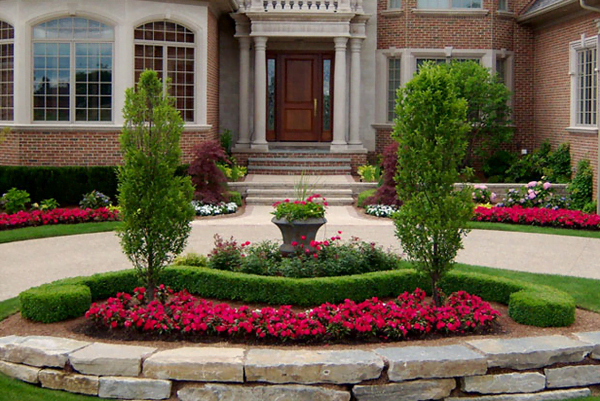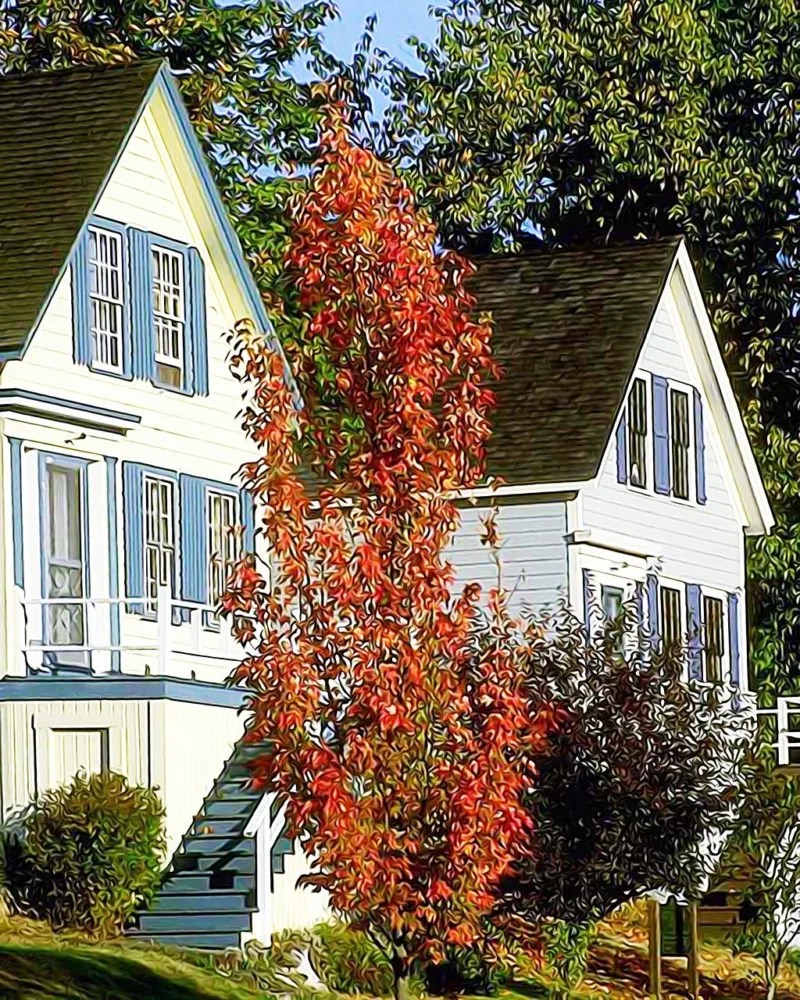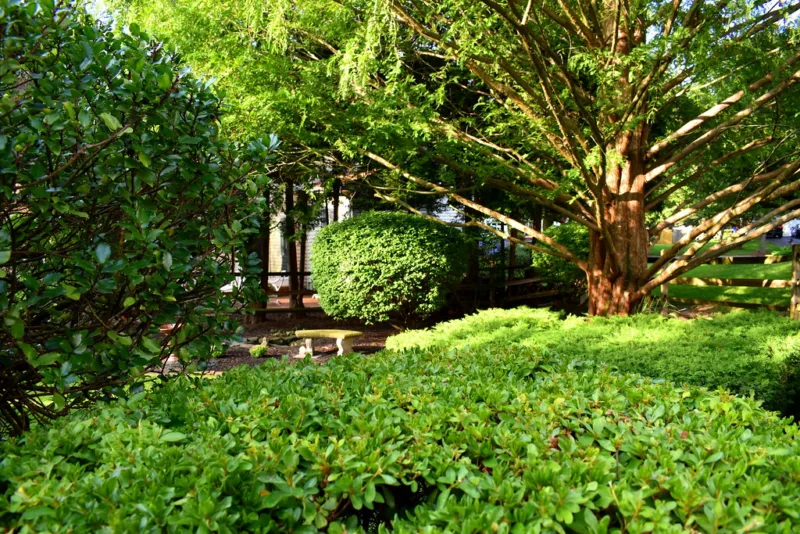Table of Contents Show
Over my years of planning landscapes, I have come across some atrocious mistakes. Usually, it is because people have just not taken the time to ask questions or do not respect the value of landscaping on their properties.
If any of the following things I say describes you, do not run to the nearest psychoanalyst or even your local garden center to beg forgiveness. It happens. I have, for the fun of it, prepared five common mistakes which can be avoided by proper planning.
For the most part, I have coined my own diagnosis of the problem. So read on, have fun, and try not to make the same mistakes!
1. “Symmetry-Itis”
Here’s a common mistake, so if this is you, you have lots of friends. This is when would-be designers try to force a symmetrical planting on an asymmetrical house plan or property.
Usually, there is only a portion of the landscape design solution that is symmetrical, and the rest is crammed in on one side to try and have an equal number of plants on either half.

Typical Symptoms:
- Two pyramidal evergreens (often cedars) on either side of the doorway
- A 4-foot-long bed on one side of the steps and a 10-foot-long bed on the other side with equal plantings and the same plants
- What is planted on the left side of the property is on the right side of the property no matter what the conditions
- Every plant or architectural item is spaced at equal distances
Solution:
Depending on the severity of the “infection“, remove any trace of symmetry by relocating the plants to a more random, less contrived pattern where possible.
Proactive Planning Measure:
Take a good look at your house and see if it is symmetrical. Chances are it isn’t, especially when the garage is attached. Enhance the asymmetry by refraining from mirroring everything you do.
Consider planting in mass on one side where you have the space with a creeping evergreen and plant a columnar or pyramidal evergreen with the same color or texture on the other side to create balance without symmetry.
2. “Repetorium Commonalis”
This ailment is similar to “Symmetry-it is“, but is more prevalent in the use of smaller shrubs and ornamental lighting. The latter can be very severe as it may invite unwanted “extraterrestrials” to land and infest the property.
It’s bad enough that most of the houses on suburban lots are identical to one another, but in this disease, this is carried into the actual landscaping solution.
This may not be a problem in orchards or vegetable gardens but can be highly uninspiring in the living areas.

Typical Symptoms:
- Every plant or architectural item is at equal distances from each other
- All the plants in the landscape are of the same scale, shape, or color
- Flowers on perennials are all the same form
- The prolific use of junipers, dwarf spirea, or potentilla in repetition
- Low voltage lighting (or worse, high voltage lighting) placed at uniform distances along a walkway or drive
Solution:
Add some variety. Remove plants randomly and replace them with something completely different than what’s there already. If it is evergreen, put it in a deciduous shrub or tree.
If it is a small bush, then replace it with something taller. If it’s a mass of spiky-type perennials, then add in something with a daisy flower.
In the severe cases where a landing strip for E.T. has been installed with the outdoor lighting, I would suggest that you remove the lights which are not illuminating a corner or entrance and redistribute the luminaries to shine onto focal points in the landscape.

Proactive Planning Measure:
Create focal points in the landscape when planning and reinforce them with night lighting, spotlights, and general illumination. Think about plant diversity, with respect to form, color, texture, and type.
Avoid too much repetition; but where warranted, consider using balance through mass.
Read Also:
3. “Genera Speciosa Apathy”
This is a relatively common psychological affliction where people are bewitched by the appeal of single genera or species of plant and as a result plant too much of it.
Very quickly, their environment becomes highly uninspiring.
Typical Symptoms:
- Mass plantings of Colorado blue spruce (Picea pungens ‘Glauca’)
- Mass planting of creeping junipers, regardless of their growing habit
- Mass plantings of shrubs or perennials of the same genera (ie. Lilium or Spiraea)

When planted in masses, blue spruces actually appear gray rather than blue, which is especially noticeable in March or early spring when skies are generally true blue and the evergreens are dirtied with ionized salts and airborne silt deposits.
Likewise, sweeping masses of junipers grow into one another over time, becoming a single plant, with the individual species almost indiscernible. If a genera-specific pathogen were to invade the garden, it would look like Europe immediately after World War II!
Solution:
Remove the occasional plant in a random fashion and replace it with complementary plants of different genera or species.
Proactive Planning Measure:
Plant a buffer using a greater diversity of plants. Introduce deciduous and evergreen trees and shrubs together, and complement plantings with perennials and annuals so that there is more variety and change throughout the seasons.
4. “Menagerie Area”
This particular ailment is exactly the opposite of the above diagnosis. It is indicated by gardeners who just can’t find it in themselves to stop buying everything they see at the garden center.
They proudly haul their new-found treasures off to their gardens and plant them out at will, whether the plants are suitable for the locations or not. Such collections usually appear more like a low-budget arboretum than a respectable garden.
Typical Symptoms:
- One of everything that grows or can grow in the area
- Homeowners can’t seem to find the plant that they want to show you – they know it’s there, somewhere – and so they relentlessly force you to look for it with them
- The yard and gardens are clearly overplanted because the owner “just had to have it“
Solution:
Besides prayer and hope, reduce the overall quantity and variety of plants to some thematic reason for having the collection.
Increase the quantity of those specific “keeper” plants which are smaller, especially those which need to be seen with a microscope to appreciate. An alternate solution might be to see if the ‘Clean Sweep‘ team will tackle this problem!
Proactive Planning Measure:
Establish a specific focus and thematic program for the garden before you buy anything.
Learn to stop and ask yourself, “Do I really need it? Does it fit with what I’m doing? Do I have a designed place for it in my garden? Is it rare and I’ll never see it available again?“
If you can answer “no” to all of them – THEN DON’T BUY IT!
5. “Excessive Superfluous Redundant Overcrowding”
This is a malady that afflicts gardeners and homeowners who have too many plants in an area which cannot sustain them.
This is usually a sign of novice gardeners who begin with the good intention of making their yard look good, but who didn’t realize that that one-gallon plant is going to get as big or bigger than the 5 or 10-gallon plant of the same species that were passed over because they just couldn’t afford it.
So instead, they bought three of the smaller ones and spaced them a foot apart to make the yard look fuller. And now, a few years later…
Typical Symptoms:
- When mature, there is no distinguishing one plant from the other (fine with a hedge, but not for an ornamental garden)
- The more aggressive plants have choked out the slower-growing, lesser aggressive ones (and as assured by Murphy’s Law, likely the most expensive or cherished ones)
- A cacophony of gnarled and twisted things that look like they may have once been branches of a plant, some with a vestige of green on them and others appearing completely devoid of life

Solution:
Tough medicine is your best hope. At this stage, save whatever, if anything, you can and start over.
Proactive Planning Measure:
Prepare a landscape plan and have someone qualified review it to see if you have too many plants. Generally, I design for plants to have enough space to grow to their fullest width for those which I want to stand out on their own.
If they are to eventually meld together, then I generally use the “three-quarter rule“. This way, I can trim the ones which need to stand out without taking too much off and let the ones I want to mass have enough breathing room and yet appear as one plant.
It cannot be over-emphasized that the preparation of a successful landscape design for northern gardens, or for anywhere for that matter, begins with some well-thought-out ideas before any ground is broken.
While still on paper, changes can be made without incurring expensive additional costs. The way to create a useful, beautiful, and enduring landscape is by following a well-thought-out design process.
It has been my experience that most problems occur when the proper time has not been taken to prepare a plan for the landscape.
Whether you hire a landscape designer, or landscape architect, or take a course to familiarize yourself with the principles of good design techniques, you must take the necessary step of planning what it is you intend to achieve.
Once you have those basic and essential pieces in place, then you can take your ideas and blend them with landscape plants and materials to create a landscape design concept that will be suitable for your cold climate garden.
So happy gardening, and have fun planning it!
Reference
- “W175-12 Common Landscape Mistakes and How to Avoid Them,” The University of Tennessee Agricultural Extension Service, W175 08-0055, https://trace.tennessee.edu/utk_agexgard/82











